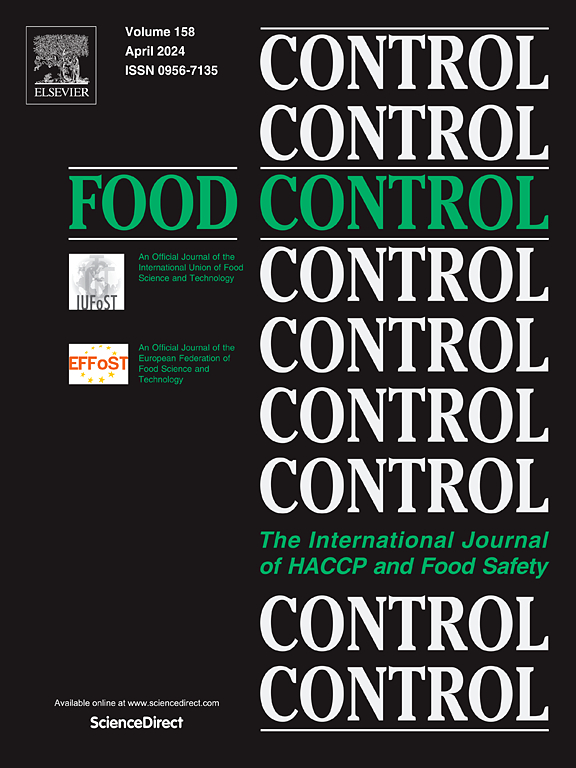关于意大利茶叶和蜂蜜中吡咯利西啶生物碱污染的食品安全问题:暴露水平和健康风险影响
IF 5.6
1区 农林科学
Q1 FOOD SCIENCE & TECHNOLOGY
引用次数: 0
摘要
研究了意大利黑茶和绿茶(Camellia sinensis L.) (n = 79)以及单花和多花蜂蜜(n = 439)样品中吡咯利西啶生物碱(PAs)及其n -氧化物(PANOs)的存在和分布。此外,该研究旨在评估意大利消费者的饮食暴露情况,并评估长期摄入PA/PANO的潜在健康风险。研究人员考虑了三种接触情况:1)单独喝茶,2)单独喝蜂蜜,3)用蜂蜜加糖的茶。在91%的茶叶样品中检测到PAs/PANOs,其中28%超过了150 μg/kg的欧洲监管限值。黑茶样品的浓度最高(1345 μg/kg),主要污染物为番茄胺、番茄胺n -氧化物和紫丁香碱n -氧化物。在蜂蜜中,25%的样品含有可量化的PA/PANO水平,平均浓度为2.00 μg/kg。百里香蜂蜜含量最高(50.0 μg/kg),其次是多花蜂蜜和蓟蜜(高达47.0 μg/kg)。亚苯胺和亚苯胺n -氧化物是检出最多的分析物。风险特征表明,饮用含有高PA/PANO浓度的茶或蜂蜜甜味茶可能对所有年龄组的重度消费者构成健康风险,其暴露边际(MoEs)接近或低于10,000安全阈值。相比之下,除了年轻消费者食用高度污染的蜂蜜外,蜂蜜本身造成的风险最小(MoEs >10,000)。总的来说,这些发现强调了持续监测PAs/PANOs和积极主动的风险管理措施的必要性,包括对欧洲立法尚未涵盖的蜂蜜等食品实施监管限制的可能性。本文章由计算机程序翻译,如有差异,请以英文原文为准。
Food safety concerns regarding pyrrolizidine alkaloid contamination in tea and honey from Italy: exposure levels and health risk implications
This study evaluated the presence and distribution of pyrrolizidine alkaloids (PAs) and their N-oxides (PANOs) in black and green tea (Camellia sinensis L.) (n = 79) and monofloral and multifloral honey (n = 439) samples from Italy. Additionally, it aimed to estimate dietary exposure and assess potential health risks from chronic PA/PANO intake among Italian consumers. Three exposure scenarios were considered: 1) tea consumption alone, 2) honey consumption alone, and 3) tea sweetened with honey. PAs/PANOs were detected in 91 % of tea samples, with 28 % exceeding the European regulatory limit of 150 μg/kg. The highest concentration (1345 μg/kg) was found in a black tea sample and lycopsamine, lycopsamine N-oxide, and echinatine N-oxide were the predominant contaminants. In honey, 25 % of samples contained quantifiable PA/PANO levels, with a mean concentration of 2.00 μg/kg. Thyme honey showed the highest levels (50.0 μg/kg), followed by multifloral and thistle honeys (up to 47.0 μg/kg). Echimidine and echimidine N-oxide were the most frequently detected analytes. Risk characterization revealed that the consumption of tea or tea sweetened with honey containing high PA/PANO concentrations can pose health risks for heavy consumers across all age groups, with margins of exposure (MoEs) falling near or below the 10,000 safety threshold. In contrast, honey alone posed minimal risk (MoEs >10,000), except for young consumers of highly contaminated honey. Overall, these findings underscore the need for ongoing PAs/PANOs monitoring and proactive risk management measures, including the potential implementation of regulatory limits for foods like honey not yet covered under European legislation.
求助全文
通过发布文献求助,成功后即可免费获取论文全文。
去求助
来源期刊

Food Control
工程技术-食品科技
CiteScore
12.20
自引率
6.70%
发文量
758
审稿时长
33 days
期刊介绍:
Food Control is an international journal that provides essential information for those involved in food safety and process control.
Food Control covers the below areas that relate to food process control or to food safety of human foods:
• Microbial food safety and antimicrobial systems
• Mycotoxins
• Hazard analysis, HACCP and food safety objectives
• Risk assessment, including microbial and chemical hazards
• Quality assurance
• Good manufacturing practices
• Food process systems design and control
• Food Packaging technology and materials in contact with foods
• Rapid methods of analysis and detection, including sensor technology
• Codes of practice, legislation and international harmonization
• Consumer issues
• Education, training and research needs.
The scope of Food Control is comprehensive and includes original research papers, authoritative reviews, short communications, comment articles that report on new developments in food control, and position papers.
 求助内容:
求助内容: 应助结果提醒方式:
应助结果提醒方式:


